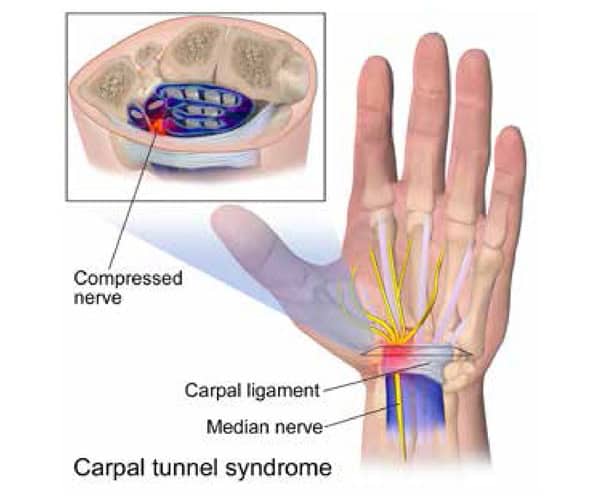Carpal tunnel syndrome (CTS) is a type of compressive neuropathy of upper limb. It is one of the common condition seen at orthopaedic clinics. Common presentations of pain, numbness and tingling sensation over hand can be due to carpal tunnel syndrome. This condition is caused when one of our main nerves to the hand, the median nerve is compressed at the level of our wrist.
Anatomy of carpal tunnel
Carpal tunnel is a passage or a tunnel at the level of our wrist. It is surrounded by the wrist bones at the base, and a strong tissue called transverse carpal ligament as its roof. Few structures pass through this carpal tunnel, which includes tendons which move our fingers and the median nerve. If the space or size of carpal tunnel is compromised, this will cause compression of the median nerve.

What are the symptoms of CTS
Common presentation is numbness and tingling sensation over the hand especially over the thumb, index, middle and ring finger. Initially, the numbness may present occasionally, but the frequency of numbness may worsen as it progresses.
Symptoms may be worse at night during sleep. This is because we tend to keep our wrist bent during sleep. Symptoms of numbness or tingling sensation can be aggravated when doing things which need us to flex our wrist, for example when holding a book or newspaper or even during driving. A lot of times, some relief is felt by shaking hands.
If left untreated, the symptoms may progress to muscle weakness where clumsiness is felt at hand. We may drop things frequently due to the weakness. In more severe cases, muscle wasting can be seen at the base of the thumb.
Symptoms of CTS
- Feeling of numbness or “pins and needles” in the fingers and gets worse at night
- Hand weakness
- Swollen feeling in the fingers
- Diffculty in gripping objects with the hand
- Burning/tingling of the thumb, index and middle fingers
- Diffculty making a fist
How is CTS diagnosed
The doctor will ask you a series of questions about your symptoms and the progression. During the evaluation, the doctor will examine to confirm the diagnosis as well as assess the severity of it. Assessment of the sensation of the hand will be done as well as testing the motor power of the thumb and fingers.
Following doctor’s examination, a few investigations can be done to confirm the diagnosis further. The most common investigation done is nerve conduction study which measures the signals conducted by the median nerve over the forearm and hand. This can determine the severity of carpal tunnel syndrome. Other less commonly done investigations include electromyogram, x-ray and MRI.
What are the treatment options?
The results of carpal tunnel release are generally good. Most patients recover well from their symptoms. In cases where surgery is done late, where there is permanent damage to the median nerve, the symptoms may not be relieved completely.
In rare occasions, recurrence of symptoms may occur which may require additional treatment or surgery.
Early detection and treatment are important. When treatment is started at early stages, the outcomes are good, and most symptoms are relieved.
Outcomes
The main prevention method is to ensure good hygiene especially of the oral cavity. No vaccines are available to date despite the 2015 vaccine for Enteroviral 71 which was implicated, but there has been no further development since. Prevention of contact with affected children should be put in place if outbreaks occur. Avoid going to nurseries when this happens.
This article first appeared in InfoMed Malaysia, Issue 24, Jan – Mar 2018.
Share:
Was this article helpful?
Share:
Was this article helpful?
Health Packages
Elevate your health with tailored health packages at Columbia Asia Hospital. Take charge of your health journey today.
AIA Policyholders Self-pay Benefits
Pink October 2024
From
RM80

